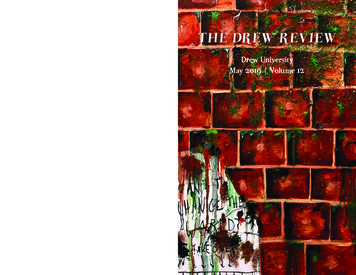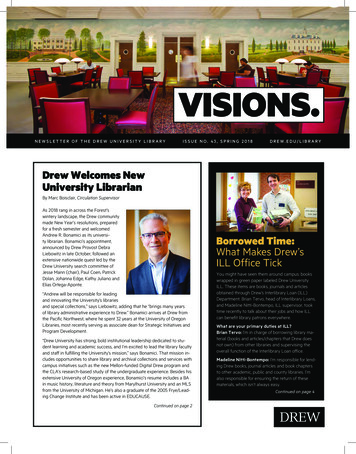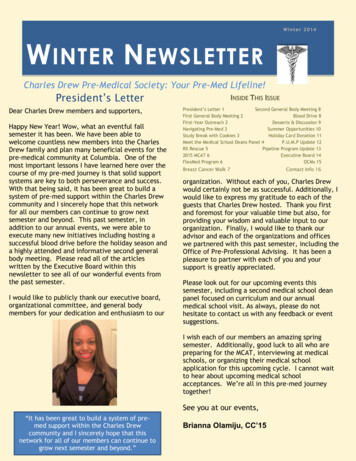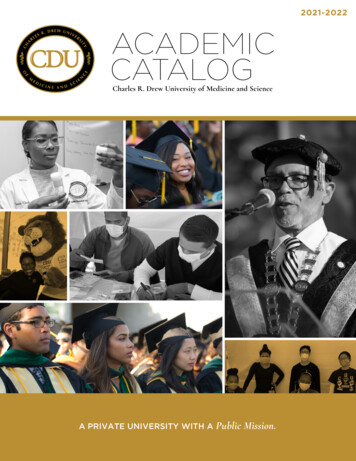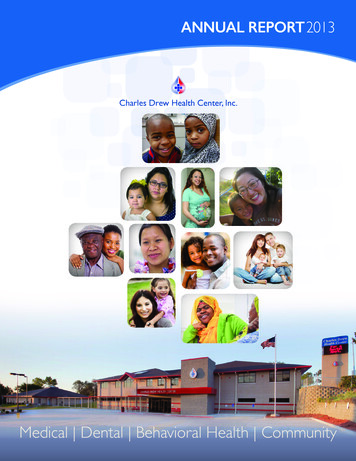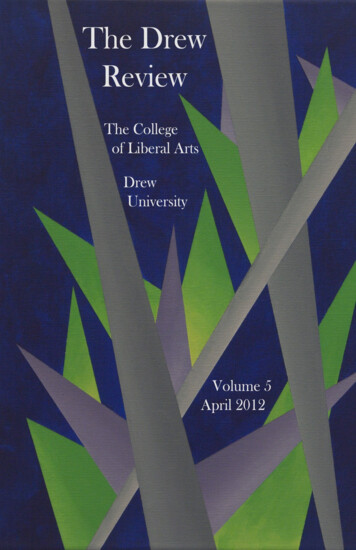
Transcription
The Drew Review is the annual research journal for theundergraduates of the Drew University College of Liberal Arts,publishing undergraduate research from the previous calendaryear. Our mission is to showcase the intellectual vibrancy of thestudents of the CLA.Currently there are five editors; editors were selected byfaculty nomination, application, and invitation. Different categoriesof membership exist, but all members are coeditors and shareequal responsibility within the journal. All eligible publishedstudents will be offered a position on the board, with the remainingpositions filled by faculty nomination and student application withwriting sample.Submissions to the Review require a faculty nomination.Students who believe their work is exceptional should approachtheir professor for a nomination. The Drew Review accepts papersof no more than twenty-five pages in October and February fromthe previous semester. Papers must be submitted with a coverletter and faculty nomination. There is a limit of five nominationsper professor per semester to guarantee a range of submissions.As we are a double-blind, peer-reviewed journal, allsubmissions should be sent as a Word document to thecorresponding editors without naming the student author orprofessor for whom the essay was written in the body of theessay. The student author‘s name and paper title should be in thefaculty nomination. Images and graphs will be published in blackand white and must be compatible with Word. It is theresponsibility of the author to make sure that all images can bereproduced. All published essays will use in-text citationsreferencing a bibliography (style of in-text reference may vary).Students can expect to be asked to make revisions prior topublication.TIMOTHY BARNUM (CLA 2013), CORRESPONDING EDITORJOHN DABROWSKI (CLA 2012), EDITOR, TREASURERJAMES FARGHER (CLA 2013), EDITORGAELAN JOHNSON (CLA 2012), EDITOR, ADVERTISINGALEXANDRA POLLOCK (CLA 2012), CORRESPONDING EDITORCOVER ART BY KRISTEN HUGG (CLA 2012)LOUIS I. HAMILTON, FACULTY ADVISORANOOP MIRPURI, FACULTY ADVISOR
THE DREW REVIEWVOLUME 5APRIL 2012TABLE OF CONTENTSWOMEN DANCING AS AN ALLEGORY FOR LOVE AND CONCORD IN THEUNIVERSE IN THE DIVINA COMMEDIAAGNES ALVES (CLA 2014)3THE EFFECTIVENESS OF THE UNITED NATIONS IN THE INCLUSION OFHUMAN RIGHTS IN COUNTER-TERRORISMSARAH CALDERONE (CLA 2013)12THE PLACE OF SUFFERING AND THE W AY TO LIBERATION INPROMETHEUS UNBOUND AND ―LINES W RITTEN AMONG THEEUGANEAN HILLS‖JAMES ROBINSON (CLA 2011)34AUTHORIAL ANXIETY AND FEMALE READERSHIP IN MARY SHELLEY‘SFRANKENSTEINVICTORIA RUSSELL (CLA 2013)51DANTE‘S PERFECT HIERARCHY: EXILE IN THE AFTERLIFE AND INFLORENCERACHEL MARIE SCHACHTER (CLA 2014)62THROUGH A SCOPE, DARKLY: A MARXIST INTERPRETATION OF CALLOF DUTY: MODERN WARFARE 2RONNIE WHALEY (CLA 2012)732
WOMEN DANCING AS AN ALLEGORY FOR LOVE AND CONCORD IN THEUNIVERSE IN THE DIVINA COMMEDIAAGNES ALVES (CLA 2014)Dante Alighieri‘s epic poem, La Divina Commedia (1308),is distinguished for its abundant and clever use of allegories thattrace Dante‘s spiritual journey from hell to heaven, which is itselfan allegory for the soul‘s journey towards and union with God. Itsnarrative and thematic constructions are based on medievalChristian theologies and philosophies, many of which derive fromor integrate ancient Greek and Roman philosophies. For example,women dancing function as symbolic representations of love andconcord in the universe that are rooted in Neoplatonic andPythagorean notions of cosmology. These reflect Dante‘s wellrounded intellectual endeavors as well as his ability (like othermedieval Christian figures looking to reconcile reason withreligion) to successfully ―weave together disparate traditions ofthought and languages‖ (Jacoff 209). Such a theme exploresDante‘s conflicted perspective on women based on their morallyvaried roles in the Commedia compared to that of themisogynistic, medieval society of Florence. It also necessarilyelicits the different secular and religious and cosmologicaloutlooks on and use of dance, including the woman‘s role in it,from relevant and integral figures in medieval Florentine society.These extremely influential Florentine ideals on the subject ofdance and women, and Dante‘s interpretation of them are whatcame to establish the symbolic role of dance, or more broadly,consistently concordant movement, as a unifying art throughoutthe three books of the Commedia. In turn, this enabled the themeof women dancing as an allegory for God‘s love and the perfectlyharmonious and therefore divinely united universe that issuedforth from that love.Dante‘s unconventional alternating portrayals in theCommedia of women as destructive, immoral, adulteratingdeceivers and temptresses, but also as astute, humble, wholeheartedly devout and, in the case of Beatrice, virtuouslytranscendent beings, provides a place for women in Dante‘s idealworld that is level with that of men. In portraying women as3
humans who are, just as men, inclined to the good andsusceptible to the bad, and act morally and immorally, theCommedia establishes an equilibrium between genders that isreflective of the essential equilibrium of the universe. In the justwill of God there is ultimate order and within that order all humansexist and possess will power and therefore have the samechances of infernal exile and celestial embrace. Dante‘s belief inthis is best exemplified by his inclusion of women on both ends ofthe moral spectrum in the Commedia. There are of course, in themain exemplar of lust in the Inferno, the ancient womenSemiramis, Cleopatra, and Helen among others (Inferno V, 5865). Women, such as Myrrah, who disguised herself as another toget in bed with her father, are punished for fraud in the eighthcircle of hell. There are, however, even more women with greatcourage and intellect among the honorable pagans of Limbo(Inferno IV, 121-128; XXX, 37-41). The Virgin Mary reigns inPurgatory as the primary example for each virtue. Faithful andloyal earthly women are thanked for the generous prayers thataided their loved ones in ascending the mountain of Purgatorymore speedily, and Matelda resides in and guides those who havearrived through the Earthly Paradise (Purgatorio XXIII, 85-93;XXXII, 82-4).The most prominent example in the Commedia of awoman who disproves the popular medieval belief that womenpossess a generally sinful and tempting disposition, however, isBeatrice. Through her virtuous nature, she surpasses the limitedcapacities of women set by such a society and even those ofhumans. She is not only the gracious object of Dante‘s desire, butin her ―gracious state,‖ a sign of his ultimate desire (unbeknownstto him yet) for God, and as such, retains the sacramental powersto act as an outlet through which to access God (Vita Nuova 35).This is one of the overriding themes of the Commedia, the loveras intercessor to (as opposed to a distraction from) God: ―whoeverspeaks with her shall speak with Him‖ (Vita Nuova 36). She is alsosacramental in the sense that she has a reformative aspect.Before acting as a guide through Paradise, Beatrice harshlycondemns Dante in the Earthly Paradise, invoking the deepestcontrition within him to repent his sins and by doing so ―acts aspriest who confesses Dante‖ and contributes to the continuingtransformation of his self (Purgatorio XXX, 103-145; Lansing 889).As women who possess such admirable and esteemed roles inthe Commedia, Beatrice, Mary and many others are4
demonstrations of the virtuous efficacy and eminence of women inChristianity. This justifies and allows women, specifically theseven dancing women in the Earthly Paradise, to serve aspersonifications for something as commendable as the sevenrotating celestial spheres of Paradise. These spheres in turnrepresent the virtues, the place of each soul in the Empyrean, andare constituents of the concordance of the universe.Dance served multiple purposes within both secular andreligious realms that were themselves extensively integrated inmedieval Florentine society. The idea of dance as having aunifying function in several areas of Florentine culture isexpressed in its versatile history within the city. It was, for themajority of its spectators, most commonly a form of entertainmentduring major festivals in the city; but in performing theserhythmically structured yet dynamically stimulating spectacles,these dancers would bring crowds of people together who wouldwatch ―l’arte giocunda‖ intently and together they would indulge inthe ―dolce effetto del dazare‖ as a form of exultant celebration(Guglielmo Ebreo, De Pratica Seu Arte Tripudii, as cited byBerghaus 56). Dance was also customary during formaloccasions, such as an aristocratic wedding, which itself is asacrament that represents love through the establishment of alifelong commitment and unity between two people. Fifteenthcentury cassoni, ―large [decorated] chests that were given to thebrides by their parents and in which their dowries were placed,‖tended to depict scenes of a wedding dance like the chiarenzana(Gombosi 291). Dance performances, specifically by women ―inhonor of high-ranking, non-Florentine visitors‖ were usedsignificantly as a political tactic in negotiating relationships withpowerful and influential figures (Bryce 1077). From a superficialperspective, these dances were just common forms ofentertainment with which to keep the city‘s guests humored. Moreintricately, however, in a predominantly male-controlledenvironment like that of medieval Florence, where women wereconsidered one of the many fruits of male establishment, danceserved as a way for a society to publically display their womenand show how well they had been preserved. Womendemonstrate the height of one‘s prestige. They represent the bestof what Florentine patrician society has to offer. They serve asexchanges of honor, capital, but especially alliances. At theinsistence of her fiancé‘s family, the Pazzi, Bianca de‘ Medicidanced for and with cardinals in an attempt to solidify ―financial5
relations between cardinals as prestigious clients and the Pazzi asinternational merchants and bankers‖ (Bryce 1082). In beinglikened to the city‘s ―resources,‖ women were used as such andcould ―be pressed into the service of the state and promotion andenhancement of civic identity‖ (Bryce 1083-4). The role of danceremains integral in this process, and not just because itappropriates the public display of women. Those thingsconsidered honorable and valuable in women of the medievalaristocracy, such as refinement, beauty, talent, virtuosity, and arelentless self-composure, are demonstrated through dance andtherefore make it an honorable art.The medieval dance masters and theorists adopted aconception of dance that is also employed by Dante throughoutthe Commedia, and reiterates Neoplatonic and Pythagoreannotions that the universe possesses an inherent order through together‖(Berghaus 44). This harmony is most commonly expressed in themotions of the celestial spheres and sustains the universe within a―unified system‖ (Berghaus 45). Pythagoras believed that ―it isthrough number that unity as primordial principle of Being extendsinto the material world and becomes multeity‖ (45). Accordingly,numbers provide a comprehensible means of explaining thefundamentals of creation in the physical world and its perfectunity. The numbers 1, 2, 3, and 4 are a tetrad and in sum theybecome the number 10, or a ―decad‖. In Christianity, a ―decad‖symbolizes divine order or God, in which everything lies and isperfectly and systematically amalgamated, like the tetrad in thedecad (45). In that sense the tetrad represents the multiplicity ofthe universe that is perfectly contained within the divine constructsof God or decad. This theory is also consistent with the medievalconstruction of ten heavens, the tenth being Empyrean, theultimate and absolute heaven in Dante‘s Paradiso in which allbeings of light (souls and angels) co-exist joyously. Put differently,the tetrad and decad are ―models of perfection,‖ creating ―unity outof [systematized] multeity, and [systematized] multeity out ofunity.‖ According to Beatrice ―this order‖ in its perfection is what―makes the universe like God‖ (Berghaus 45; Paradiso I, 104-5).In addition, Pythagoras taught that these same numericalprinciples could also be applied, along with ―concordant musicalsounds,‖ to the ―rhythmic structure‖ of dance, and in doing so,properly articulated through the body ―the concord of the heavenly6
spheres‖ (Berghaus 45). For that reason, in his medieval dancetreatise, Dialogo del Ballo (1555), Rinaldo Corso argues thatbecause, in its noblest form, dance is a demonstration of God‘sperfection reflected in the divine harmony of the universe and istherefore the result of ―furore,‖ it is a ―virtuous, even sacred artform‖ (Berghaus 61; Corso, Dialogo del Ballo, as cited byBerghaus 62). Taking this a little further, Christianity deemscreation as an act of God so that He might see ―his splendor‖ that―Eternal Love,‖ from which all things came into being, reflectedback onto Him through ―new loves,‖ in which all things continue topersist (Paradiso XXIX, 14, 18). It is through love that everythingbecomes naturally inclined to desire God and in doing so movesthe universe in its attempt to get closer to Him, and therefore,perfection. To do so, it must work perfectly. Hence, the essentialexistence of dance, or the consistently rational and concordantmovement that ―came into being contemporaneously with theprimal origin of the universe together with love,‖ through whichlove divinely works to unify the universe with God (Berghaus 48).In this way, dance is itself divine and the most complete andunifying of all art forms. This is exemplified throughout theCommedia through movement itself. As Dante travels from hell toheaven, closer to God and with each step his love for Him betterrealized, movement within these realms becomes increasinglyordered and uniform until it can actually be distinguished as dancein Purgatory and even further a ―celestial ballet‖ in heaven.In the Inferno, where lost souls who submitted themselvesto the confines of sin suffer in perpetual damnation, there reignschaos and disorder in every facet, including the souls‘movements. These souls were significantly ―diverted by falsepleasures‖ that misled them, confined them to sin and ―turned[them] toward earth,‖ in the wrong direction away from God(Paradiso I, 134-5). It made slaves of them on earth as it doesmore obviously now in hell, subjecting them to irrational andpointless punishment, as they had acted irrationally andpointlessly on earth. Such is the case for the avaricious and theprodigal in the Fourth Circle as they ―dance their round dance,‖―wheeling weights, they used their chests to push‖ in opposingdirections and so each would only get halfway before ―shatteringthe other when they meet‖ like a dysfunctional and ―bizarre pas dedeux‖ (Inferno VII, 23-4, 27). These ineffective and absurd actsare a metaphor for their behaviors on earth in full pursuit ofsomething as trivial and unfulfilling as material gain. Because this7
is unfulfilling, the souls blindly sought more to fill in the void,practicing immoderation. In this way they had no measures.Without measure, how could one keep track of and ―follow the onetrue path?‖ (Paradiso XXIX, 86). They did not, and they fell intodisarray. Similarly, the souls who indulged in lustful acts andwhose desires were disoriented, like the tragic lovers Paolo andFrancesca, were themselves in hell disoriented by ―the hellishhurricane, which never rests, drives on the spirits with itsviolence now here, now there, now down, now up, it drivesthem‖ (Inferno V, 31-2, 43). It seemed almost like a sloppy, neverending waltz that depended less on the dancers‘ abilities to keepup than it did the wind and storm to keep them going. It wascompletely chaotic and disordered and in that sense hardlyrecognized as dance. By exclusively tending to their own selfishand therefore limited desires which only brought immediate andtemporary fulfillment, with disregard to the harm it would causeothers and ultimately themselves in the long run, they acted out oforder with God‘s will, much less in love of Him. Hence, the blindedsouls who ―when they come up against the ruined slope theycurse the force of the divine,‖ reaffirm in their misplaced hatredand therefore misplaced desire, their inability to reason as to whythey are justly there (Inferno V, 34, 36). In the irrationality of theiracts and of their movements they reveal how fragmented anddetached from God they are.In Purgatorio on the other hand things are literally lookingup. The souls look up intently, ―keeping their eyes on the heavenlywheels‖ as they move in the same orderly direction towards them(Purgatorio VIII, 18). Many of these souls by one last act ofcontrition demonstrate goodness, meaning that they still lovedGod and hence they were saved. Now in Purgatory they purgethemselves of sin once and for all and prepare to enter theheavenly dominion. They do so by redirecting their desire to God,nurturing the intellect through reasoning of their sins that allowthem to understand God, and reestablishing the will so that itbecomes one with God‘s will. These are the three components ofone‘s self that must be properly governed, wholly intact, anddirected to the same end so that one may move more swiftly andaccordingly to God in Paradise: he is made whole the closer hegets to Him. This constitutes yet another set of forces that must bein harmony to partake in God and it is here in Purgatory that theyare harmonized. This supports the argument of the 15 th centurydance master, Domenico da Piacenza, in defense of the noble art8
of dance. He believed dance, properly done, was ―an exercise toincrease moral and intellectual virtue‖ because it implemented―misura, memoria, agilitade e maniera‖ and in doing so took asmuch ―inteletto e fatica‖ as one could find (Domenico da Piacenza,De Arte Saltanda et Choreas Ducend, as cited by Smith 18). Itcould be argued that the gluttonous demonstrated some of thesame characteristics when, as if led by a drill sergeant, withmisura (measure) and fatica (effort), the shades –who were ―soemaciated that their taut skin took shape from bones beneath‖—ran in a ―file‖ round the mountain reciting, with such memoria(memory) and inteletto (intellect), examples of temperance as ameans of redemption (Purgatorio XXII, 142-54; XXIII, 23-4, 66).One can see the calculated and ordered movements associatedwith dance begin to take shape in this example. It also implies thatthose things that call for the extensive application of one‘s intellectand effort in fulfilling them must be righteous, and that would makesense because that which requires full exertion of one‘s intellectand effort (fulfilling God‘s will) is the essence of righteousness.Because dance ―exercises‖ the intellect and requires that both―body and mind are in harmony with each other,‖ it significantlyaids in establishing a more virtuous, whole and therefore unifyingself, the goal of those in Purgatory (Berghaus 59). Additionally, themost well-regarded dance master in medieval Italy, GuglielmoEbreo, believed that from dance, which presents in its movementsa ―rational order of things beauty, goodness, and virtue arederived‖ (Berghaus 59). It is no coincidence that at the top ofMount Purgatory in the Earthly Paradise, where on the verge ofcelestial embrace the earth comes closest to God, dance canfinally be distinguished as the seven virtuously harmoniousspheres personified by ―three circling women‖ and ―four otherwomen [who], dressed in crimson, danced‖ (Purgatorio XXIX, 121,130-1).Finally, Paradiso is where dance in its most precisedefinition takes form and has its most eminent position indisplaying and sustaining the perfection of the universe. It is herethat Dante‘s doubts are put to rest and each perplexitydisregarded if not solved as he comes to know more and moreabout the nature of God's ways and the deft motions of dancebecome more and more recognizable. These souls go as far asforming words and the image of an eagle ―in their lights‖ and ―intheir flights‖ as they teach Dante the value of the virtue of justicein the sphere of Jupiter (Paradiso XVIII, 76-7). Here, dance can be9
seen everywhere and only grows in aspiration the farther uptoward Empyrean one goes. From the souls in the sphere ofMercury who ―moved within their dance, as if they were swiftestsparks‖ to the two rings consisting of the souls from the two saintlyorders of St. Dominic and St. Francis, revolving jubilantly andconcordantly around Dante and Beatrice, ―motion matched withmotion, song with song‖ (Paradiso VII, 7-8; XII, 6 ). It is in themeasure of their love that these beings of light are variouslyordered and differ in ―radiance, more brightly or subdued‖ as wellas speed (Paradiso XXIX, 141). Although initially this may seem tobe implying disproportion to the essentially balanced universe ofGod, it actually lends to that balance. According to FrancescoGiorgio‘s De harmonia mundi, ―the consonance of cosmic bodiesoccurs when equal and unequal things are brought into cohesion.‖Unequal things, even tendencies, must exist in order to establishconcord in the first place (Berghaus 51). The souls are content intheir place and in the proportion of love that God has allotted thembecause they do not long to love God most, but to be perfectlyunited with Him. To do so, one‘s desires must align with that ofGod. Piccarda, the first soul Dante encounters in Paradise,explains that ―all this kingdom wills that which will please the Kingwhose will is rule.‖ Thus their ―will becomes one single will,‖ that ofGod‘s, and ―in His will there is our peace‖ (Paradiso III, 81, 83-5).Furthermore, in a perfectly concordant universe there is no needfor discord because all things agree with each other in theirlongings, as represented by and in their movements or dances.Although different in their virtues and love for the Lord, they allwant the same thing, God, and in their common need are broughttogether to love each other in love of God and in this way they areperfectly unified.Finally, in the engagement of dance one works throughdifferent, yet essentially agreeable and corresponding movementsthat sustain each other towards a common end. In medievalChristianity, the seven celestial spheres of the universe and thesouls that inhabit them are urged by their love for God to becomeincreasingly concordant and unified to each other, and ultimatelyto God, in their love. As a result, this growing unity andconcordance is physically expressed in their motions, as theymove closer to God and the eternal Paradise. This increasingorder and unity in movement can also be recognized in the soulsas Dante moves from the Inferno to Paradiso, until it can actuallybe distinguished as dance at the end of Purgatorio and throughout10
Paradisio. In this way, the seven perpetually moving celestialspheres are representations of love and the harmonious universeand, because the seven ladies from the Earthly Paradise serve asrepresentations of these spheres and personify their movementsthrough dance, they too are symbolic representations of love andthe harmony of the universe under God.Works CitedDante, Alighieri, and Allen Mandelbaum. The Divine Comedy ofDante Alighieri, Inferno: a Verse Translation, with anIntroduction by Allen Mandelbaum. New York, NY:Bantam, 1982. Print.Dante, Alighieri, and Allen Mandelbaum. The Divine Comedy ofDante Alighieri Purgatorio: a Verse Translation, with anIntroduction. New York, NY: Bantam, 1984. Print.Dante, Alighieri, and Allen Mandelbaum. The Divine Comedy ofDante Alighieri Paradiso: a Verse Translation, with anIntroduction. New York, NY: Bantam, 1986. Print.Smith, A. William. "References to Dance in Fifteenth-CenturyItalian "Sacre Rappresentazioni"" Dance Research Journal23 (1991). JSTOR. Web. 27 Oct. 2011. http://www.jstor.org/stable/1478694 . .Bryce, Judith. "Performing for Strangers: Women, Dance, andMusic in Quattrocento Florence." Renaissance Quarterly54 (2001). JSTOR. Web. 27 Oct. 2011. http://www.jstor.org/stable/1261967 . .Berghaus, Günter. "Neoplatonic and Pythagorean Notions ofWorld Harmony and Unity and Their Influence onRenaissance Dance Theory." The Journal of the Societyfor Dance Research 10.2 (1992). JSTOR. Web. 28 Oct.2011. http://www.jstor.org/stable/1290654 .Gombosi, Otto. "About Dance and Dance Music in the Late MiddleAges." The Musical Quarterly 27.3 (1941). JSTOR. Web.28 Oct. 2011. http://www.jstor.org/stable/739387 .Lansing, Richard H., and Teodolinda Barolini. "Women." TheDante Encyclopedia. New York: Garland Pub., 2000. Print.11
THE EFFECTIVENESS OF THE UNITED NATIONS IN THE INCLUSION OFHUMAN RIGHTS IN COUNTER-TERRORISMSARAH CALDERONE (CLA 2013)After the events of September 11, 2001, the United Nations(UN), and specifically the Security Council (Council), becameengaged in efforts to place counter-terrorism in a more prominentposition than it had been. This is especially seen in Councilresolutions 1368 and 1373, passed just one day (2001a) and littleover two weeks after the attacks (2001b), respectively. In additionto calling upon states to combat terrorism in a number of ways,resolution 1373 even went so far as to call for the creation of acommittee under the Security Council ―to monitor implementationof this resolution‖ (UN Security Council 2001b), which wouldbecome the Counter-Terrorism Committee (CTC or Committee).However, one important aspect was missing from these hastyattempts at including counter-terrorism in the UN dialogue. Thewords ―human rights‖ were never included in the initial resolutioncondemning the attacks on September 11 th and ordering states toadopt measures combating terrorism (UN Security Council2001a). The term was mentioned just once in resolution 1373,only in regard to granting refugee status (CTC ―Human Rights‖2011).This initial exclusion of human rights from the counterterrorism dialogue reflects how the matter would be treated for thenext few years. In 2002, the first chair of the CTC even stated that―monitoring performance against other international conventions,including human rights law, is outside of the scope of the mandate‖ (CTC ―Human Rights‖ 2011). Only after human rightsabuses had been committed in the name of counter-terrorismduring these years did the Security Council and CTC turn attentionto human rights in counter-terrorism. In fact, the CounterTerrorism Executive Directorate (CTED or Executive Directorate),established by resolution 1535 (CTC ―Human Rights‖ 2011),would become a body meant to work closely with states throughcountry visits and confidential reports (Restrepo 2011), includingon human rights (CTC ―Human Rights‖ 2011). Efforts have been12
made to include human rights in the counter-terrorism dialogue,but how effective have they been?Rosemary Foot explored this question, arguing that ―thepower of the human rights norm has been demonstrated withinthe setting of the UN‖ (2007, 513), with ―moves‖ and ―arguments‖allowing for a ―deepening of procedures that are attentive tohuman rights‖ (2007, 511). This may be true within the UN as awhole, but is this norm so powerful in countering terrorism? Whatkind of effect does this norm have on the wider internationalcommunity in this regard? Focusing on UN efforts in the SecurityCouncil, CTC, and CTED, this paper will argue that despite someprogressive measures to include human rights in counterterrorism, these are overshadowed by the overt weaknesses interms of the initial exclusion of human rights, inadequate reforms,and the subsequent effects on the international community as awhole that must be addressed in order to give human rights amore substantial position in the counter-terrorism dialogue.First, the paper will provide a brief history of UN counterterrorism efforts, along with human rights abuses that took placein the name of counter-terrorism, including the examples of China,Russia, and the United States (US), and attempts at inclusion ofhuman rights in counter-terrorism at the UN. Then, the importanceof including human rights at the time of these attempts will behighlighted, along with hopes conveyed for these measures.Despite these most recent reforms, limitations and weaknesses ofthe UN, especially CTC and CTED, and the effect on theinternational community as a whole, will be considered. Finally,the conclusion will discuss reforms, especially in relation to CTED,that may be possible to create a more effective human rightsaspect of counter-terrorism, all within the boundaries of whatother UN bodies are able to do already, which may be helpfulgiven the upcoming 2012 interim review of CTED called for byresolution 1963 (UN Security Council 2010).History of Counter-Terrorism and Inclusion of Human Rightsat the UNBefore the events of September 11, 2001, the UN hadlittle part in counter-terrorism efforts as a whole, with inability onthe General Assembly‘s part to create a convention againstterrorism and an overall lack of attention by the Security Council tothis issue (Messmer and Yordan 2010, 173). The action by the13
Council prior to the events of September 11 th concerning terrorismwere limited due to the thought that these issues were betteraddressed nationally (Messmer and Yordan 2010, 173). Thesemeasures included sanctions against countries believed to beconnected to terrorism, resolution 1269 of 1999 requesting statesto work together against terrorist acts, and the creation of what iscalled the ―1267 Committee,‖ which monitored sanctions againstthe Taliban and Al Qaeda (UN ―Security Council Actions‖ 2011).However, the events of September 11, 2001 became thecatalyst for change in UN, and especially Security Council,attention to counter-terrorism efforts. Just
The Drew Review is the annual research journal for the undergraduates of the Drew University College of Liberal Arts, publishing undergraduate research from the previous calendar year. Our mission is to showcase the intellectual vibrancy of the students of the CLA. Currently there are five editors; editors were selected by .



